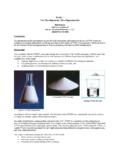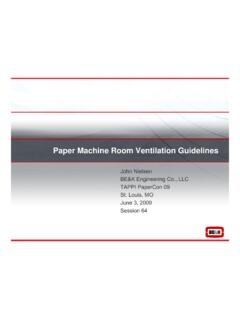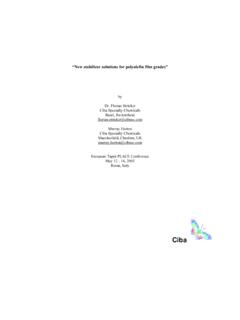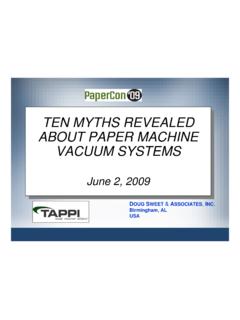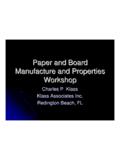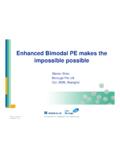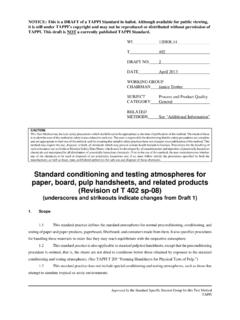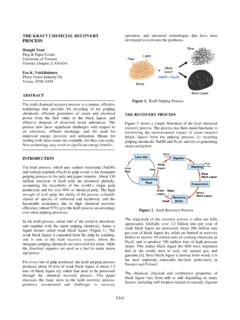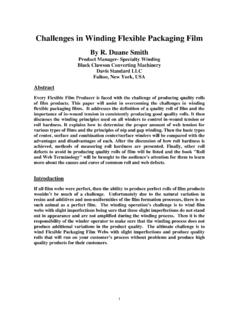Transcription of New EVAL® EVOH Resins for Flexible Packaging
1 New EVAL EVOH Resins for Flexible Packaging Robert B. Armstrong EVAL Americas (USA) ABSTRACT Due to higher productivity, lower cost, and diverse function, coextrusion coating has come to be regarded as an excellent method of manufacturing composite Packaging . An important application for EVOH (ethylene vinyl alcohol) barrier resin is in coextrusion coating, where EVOH is used in conjunction with paper, foil and other plastics for Flexible and semi-rigid containers. Taking advantage of EVOH s high speed processability and superior pinhole resistance, plus flavor, odor and gas barrier properties, EVOH/Paper, EVOH/Polyolefin, and EVOH/Paper/Aluminum containers and Flexible have been very successful in the marketplace.
2 This paper is a review of the balance of processability, thermal stability and barrier properties in various EVAL EVOH (ethylene vinyl alcohol) Resins typically used in coextrusion coating. This paper will discuss the use of EVOH of varying mol% ethylene, including new grades of EVOH optimized for high speed coextrusion coating and laminating, including basic properties and processability, gas, flavor and aroma barrier properties, thermal stability, and an overview of applications and structures. INTRODUCTION The high barrier Packaging market in the United States continues to experience strong sustained growth. EVOH (Ethylene vinyl alcohol copolymer) barrier resin is often used in new applications in high barrier Flexible Packaging because of its outstanding gas barrier properties, excellent organoleptic properties, and easy processability on a wide range of conventional coextrusion processing equipment.
3 Coextrusion coating and laminating is a technology originally developed in the nineteen forties and fifties, which has constantly evolved in the years since into a technologically sophisticated synthesis of equipment, materials and processing knowledge. Today coextrusion coating and laminating offers high productivity, low cost, and diverse function. Progress has been driven by response to consumer demands for greater convenience, variety and improved product quality. Developments to improve the original Dupont coextrusion coating die technology include automatic profile control dies, multi manifold feed blocks, gravimetric feed systems and computerized process control systems. The development of improved equipment must be matched by improved materials, and resin suppliers of EVOH are striving to improve the barrier, thermal stability, degradation resistance and processability of EVOH Resins to meet the needs of a demanding and competitive segment of the Packaging industry.
4 This paper will review the need for barrier, particularly to oxygen in Flexible Packaging , the value that EVOH offers in high barrier Flexible Packaging and the properties of EVOH which are desirable in coextrusion coating and laminating. The combination of improved coextrusion technology, processing knowledge and EVOH Resins is expected to allow for continued replacement of metal and glass Packaging with high barrier Flexible Packaging . EXAMPLE of MARKET APPLICATION Packaging and Degradation of Food While innovative Packaging continues to amaze in the ways that it promotes product, offers ease of opening, increases consumer convenience or differentiates one supplier from another, the primary purpose of Packaging remains to contain and preserve the packaged product.
5 Foods are by their nature perishable, and the period of time during processing and storage when foods are still of acceptable quality is defined as the useful shelf life of that foodstuff. There are three primary ways by which food products degrade, to the point where they are either unpalatable, or could be harmful to the person consuming them. The first degradation route is physical damage or bruising, which is not significant for the purpose of this paper. The second route is through chemical changes that can cause deterioration of the food and reduce shelf life. The chemical changes can include oxidative reactions, lipid oxidation, and enzymatic actions that can change the appearance of food, and make it unfit for consumption.
6 For example dried snacks such as potato chips are susceptible to enzymatic degradation and biological attack. Fat, which contributes to the chips flavor and texture must be protected from oxidative degradation (rancidity). The third route is through microbiological changes, since microbes can multiply rapidly under favorable conditions, and many food products have low resistance to microbe growth once they are harvested or processed. Microbiological growth eventually results in unsavory food taste and appearance and can also cause food to become unsafe for human consumption. Some microorganisms such as Salmonella and Escherichia coli directly cause infection, while Clostridium botulinum and Staphylococcus aureus produce toxins that directly affect humans.
7 To maximize shelf life of food, several key environmental factors including temperature, water content and composition of atmospheric gases surrounding a product should be controlled. Given that both chemical changes such as oxidation, and microbiological growth can be accelerated in the presence of oxygen, controlling the oxygen content in a package or the rate of oxygen ingress into a package is often one of the most critical attributes of barrier Packaging . A starting point for a package design could be the permeation targets in the table below, which show the maximum acceptable oxygen gain in several different types of food. Table I. Permeation Targets for Selected Foods Food or Beverage Maximum Oxygen Ingress permissible ppm (mass basis) Maximum Water Gain or Loss % (mass basis)
8 Canned milk, meats, fish and poultry 1 5 3% loss Beer, ale, wine 1 5 3% loss 20% CO2 or SO2 loss Canned vegetables, soups, spaghetti, catsup, sauces 1 5 3% loss Canned fruit 5 15 3% loss Dried foods 5 15 1 % gain Carbonated soft drinks 10 40 3% loss Fruit juices, drinks 10 40 3% loss Oils, shortening 50 200 10% gain Salad dressings 50 200 10% gain Peanut butter 50 200 10% gain Jams, jellies, syrups, pickles, olives vinegar 50 200 3% loss While these targets and the subsequent calculations should not be considered definitive, they can be used as a guide, and the starting point for creation of a barrier package. As an example we will consider the Packaging requirements of dried foods such as potato chips as being <10ppm oxygen ingress and <1% weight gain of moisture COMPARISION and SELECTION OF BARRIER MATERIALS Traditionally extrusion coaters have relied upon aluminum foil to meet needs of high barrier Flexible Packaging .
9 Foil is an attractive option, offering barrier to gases, moisture and radiation. Packaging comprised of foil, paper and polyethylene offer outstanding attributes at a very reasonable cost. However there are negative attributes to this type of laminate, including poor flex crack resistance, non existent thermoformability or orientability, susceptibility to attack by acidic foods, non-microwavable and opaqueness, not forgetting recycling difficulties. The negative issues with foil can be overcome by using barrier polymers such as Nylon, PVdC or EVOH. However these polymers are all permeable to small molecule gases such as oxygen, nitrogen and carbon dioxide. A table of barrier properties to oxygen and moisture would be necessary to meet the permeation targets in Table 1.
10 Once a reliable reference table of oxygen and moisture barrier has been secured, a package designer can then choose the material, or combination of materials that will meet the barrier target initially selected. Table II. Barrier Comparison of Various Polymers MATERIAL OTR @ 25 C, 65% RH ( sq. ) MVTR @ 40 C, 90% RH (gram-mil/100 sq. ) EVOH ~ ~ PVdC ~ ~ Acrylonitrile MXD6
